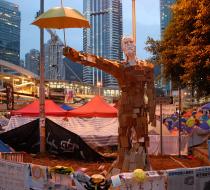Umbrella Man - Occupy Central Hong Kong 1 Favorite
The pro-democracy protests in Hong Kong have a new mascot: a roughly 12-foot-high figure of wood blocks holding a bright yellow umbrella in its outstretched right hand. The students call it Umbrella Man.
Umbrellas emerged as a symbol of the demonstrations after dozens of students wielded them on the night of Sept. 28 to fend off pepper spray as they jostled with the police.
The statue’s main creator, a 22-year-old recent college graduate, transported it to the protest in a van and carefully moved it into position on the wide avenue in front of the Hong Kong government’s headquarters. But he was clearly nervous about the political implications of the fragile statue and would only identify himself by a nickname, Milk. He said he came up with the idea soon after the sit-ins began a week ago and built it with the help of three or four friends.
For many onlookers, especially the older ones, the statue immediately evoked the 33-foot Goddess of Democracy sculpture created by Beijing students in the spring of 1989 and exhibited in Tiananmen Square in the days before a military assault killed hundreds of people. People’s Liberation Army troops toppled and destroyed the statue during the crackdown.
Milk, who wore a dark blue T-shirt, said he understood the comparison, but insisted that it had not occurred to him as he was making “Umbrella Man.”
“I didn’t realize that,” he said. “It has a different meaning to me, just freedom and peace.”
Milk said that he was uncomfortable with the attention the statue instantly received, and that his goal had been partly artistic. “I’m not trying to achieve anything. Art is just an expression,” he said. “The movement needs something just to stand here.”
The statue also seems to draw inspiration from the viral image of an "Umbrella Man" amidst police teargas. The picture of Umbrella Man is a stunning image, showing a young man dressed in black, surrounded in a miasma of teargas, his arms raised. He holds a tattered umbrella high above his head, which does nothing to protect him from the fumes.
His vulnerability is clear, especially in contrast with the semi-circle of riot police surrounding him, all wearing fluorescent yellow vests and space-age protective helmets. His stance radiates self-confidence, perhaps reflecting the protestors’ sense of moral rectitude; they want Beijing to allow them universal suffrage in selecting their Chief Executive. It’s a very powerful image, yet it still doesn’t quite have the gut-punch of Tank Man, who is literally putting his life on the line.
Told that he would inevitably be compared to Ai Weiwei, the dissident artist in Beijing, Milk cringed slightly and said again that he did not want to give his real name.
Protesters seemed enthusiastic about the sculpture. “I think it is creative and meaningful. It represents us and our cause,” said Tinnie Lau, a 24-year-old administrative worker.
Milk said that he was an only child who had spent his entire life in Hong Kong and had studied videography in college.
Friends strung ropes around the body of the statue to help stabilize it because it seemed prone to falling forward. Milk explained apologetically that the statue had been slightly damaged in the van on the way to the protest site. “The structure,” he said, “is a little bit unstable.”
The students have two basic requests. First, that an authentic election with universal suffrage be held in 2017, with no vetting of candidates by a pro-Beijing committee. Second, that current Hong Kong Chief Executive Leung Chun-ying steps down.
It is unlikely that Beijing will allow free elections in Hong Kong — or any part of China. Since his election as president of China on March 13, 2013, Xi Jinping has been consolidating power. His anti-corruption campaigns have won him popularity among the Chinese populace. He has built a reputation as a strong leader by resisting opposition and international pressure.







